-
Start
-
Daereungwon Ancient Tombs
-
Cheomseongdae
-
Gyochon Village
-
Gyeongju National Museum
-
Bulguksa Temple
-
Bomun Tourist Complex
-
Gyeongju Tower
-
Bunhwangsa Temple
-
Food
-
Finish
The yellow sun beyond the mountain looked like the night view we have seen last night. The night view was very impressive, we kept thought of it.

We wanted to go out as soon as we can and look and feel many things, as we slept tight in the comfortable resort. But because today's schedule is a bit loose than yesterday, we started our second day with relax.
Bunhwangsa Temple 분황사
It is said that long ago, China's emperor of Tang Dynasty had sent a big picture of peony blossom flower. But because there were no bees or butterflies in it, queen Seonduk thought he was insinuating against her, as if she is a peony blossom flower with no fragrance. So she ordered to build Bunhwangsa Temple, thinking herself as a beautiful flower with a fragrance.

Today's first schedule is to look around queen Seonduk's Bunhwangsa Temple, the temple with fragrance. Bunhwangsa Temple is the temple where Saint Wonhyo, a contemporary eminent Buddhist priest had stayed, and it is also close to Hwangnyongsa, Silla's best temple.

Bunhwangsa Temple is located at the end of the downtown, not far away from Gyeongju station. It is surrounded with trees, maybe that's why there were not many tourists there.
Bunhwangsa Temple had played many roles in Silla's history, and has kept it's importance until todat. But another thing that made the temple famous is the Bunhwangsa Temple stone pagoda (National Treasure no.30), Silla's first stone pagoda.

When you enter the entrance, the large stone pagoda will come in your eyes. According to the shape of the stereobate and the shape of the tower, it is assumed that the tower is a 7~9 floor rock tower. And it is said as Stone Brick Pagoda (模塼石塔), a tower made of small rocks shaped into bricks.

Inside the tabernacle, there is a statue of the Buddha seen through the slightly open door. There are lion statues at every corner of the tower and at the 4 parts are 2 Inwangsangs each. Inside the tabernacle many ruins were found, including the inside sarira case and bead.
This Bunhwangsa Temple Stone Brick Pagoda is in the middle of wooden tower and rock tower. It is a very important cultural asset for the research of Silla's rock tower history.

Behind the Stone Brick Pagoda is the place where Hwajaeng Guksa monument used to be, but now there is only a part left. Hwajaeng Guksa monument is made in Goryeo era, to praise Saint Wonhyo who stayed here and wrote Hwaeomgyeongso.

On the left side of Hwajaeng Guksa monument part is the Seokjeong well, according to The Heritage of the Three States there is a legend that dragon that protects the country is living in it.
Seokjeong is also called as Samnyongbyeon well. Seokjeong's outside is 8 angles and the inside is round and it is in grid pattern. Each of the angles resembles the Noble Eightfold Path and Wonlyiung's truth and the four unchangable truths. But unfortunately, in the well there were statue of Buddhas with broken heads, happened by the policy of suppressing Buddhism in Joseon era.

And another statue of Buddha with it's face wrecked was in the temple, keeping it's place quietly.
And it is said that the painting of Solgeo, 'Painting of Avalokitesvara Bodhisattva ' and a wall painting that is the background of the native songs 'Dochunsudaebiga' used to be here, but nowadays there are nothing left.

A little behind is Bogwangjeon, where Bunhwangsa Temple Standing Stone Buddha, a statue of Buddha of Joseon dynasty is kept. A tourist who seems to be a Buddhism believer is bowing in Bogwangjeon. At the back side, believers are talking to each other while wiping brasswares.

At Bunhwangsa Temple, you can try ringing the Buddhist Bell, although it's not an experience.
Instead, you should be careful, ring it once slightly within 30cm.
Even though I rang it very slightly, the ringing sound of the Buddhist Bell surrounded the temple, making my mind calm. I like these kind of sounds, not minding whatever religion.
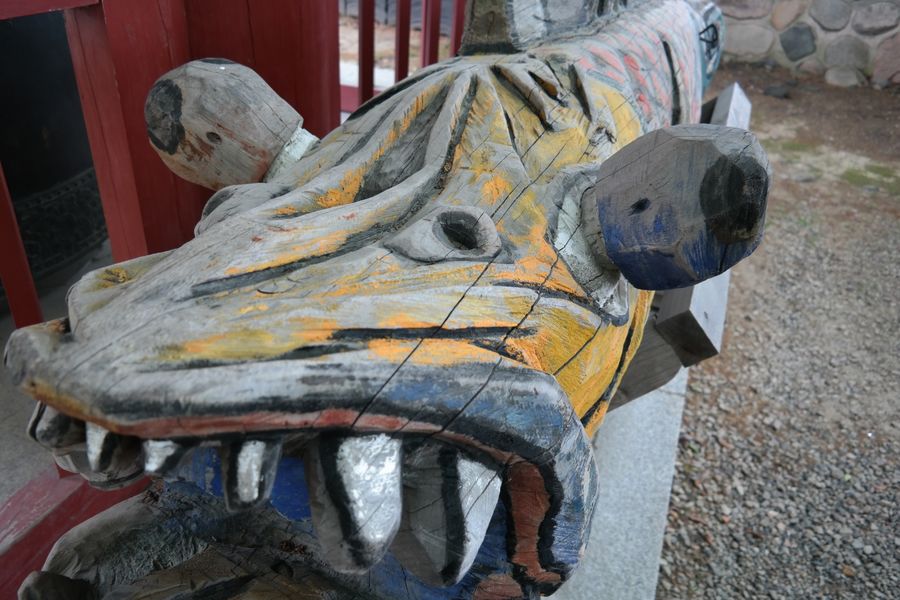
Next to the Buddhist Bell is a fish-looking log with a funny face. It is a wooden fish of Bunhwangsa Temple, and actually it should be hung and used to make noise at temples, when wood is put in the log's carved furrow at it's stomach. But it isn't used for it, watching people with it's bulgy eyes at a corner.

Canon DIGITAL IXUS 65 | f/4.0 | 2014:04:27 12:40:26 | Flash did not fire, auto mode | 12.12mm
When you finish looking around Bunhwangsa Temple and walk out of the place, in the front you can see 'Guhwang-dong Flagpole Support' standing in the middle of rape blossom flowers.

The wide plain beyond the rape blossom flowers is the Hwangnyongsa site, the place I explained before in Bomun Tourist Complex, the owner of Hwangnyongsa site 9 floor wooden tower.
There are many tourists that come by small Bunhwangsa Temple, but Hwangnyongsa, which was once the best temple of Silla is now nothing left, buried under the rape blossom flowers with bees buzzing by.
Address: Gyeongju, Gyeongsangbuk-do guhwangdong 313 (경상북도 경주시 구황동 313)
Phone Number: 054-742-9922
Opening hours: 08:00 to 18:00
Homepage: http://www.bunhwangsa.org/
Myeongdong Jjolmyeon 명동쫄면
We went in Myeongdong Jjolmyeon in the downtown, one of the famous restaurants of Gyeongju to have a brunch.

This is a Jjolmyeon(Spicy Cold Chewy Noodles) specialty store that has existed over 30 years and been on-air too, there's always a long line of customers.

And also today, there was a long line of people inside the store and outside into the alley.

There are only 4 menus, bibim Jjolmyeon, fried tofu Jjolmyeon, odeng Jjolmyeon and cold Jjolmyeon. Hmm, the true delicious restaurants always don't have many menus.
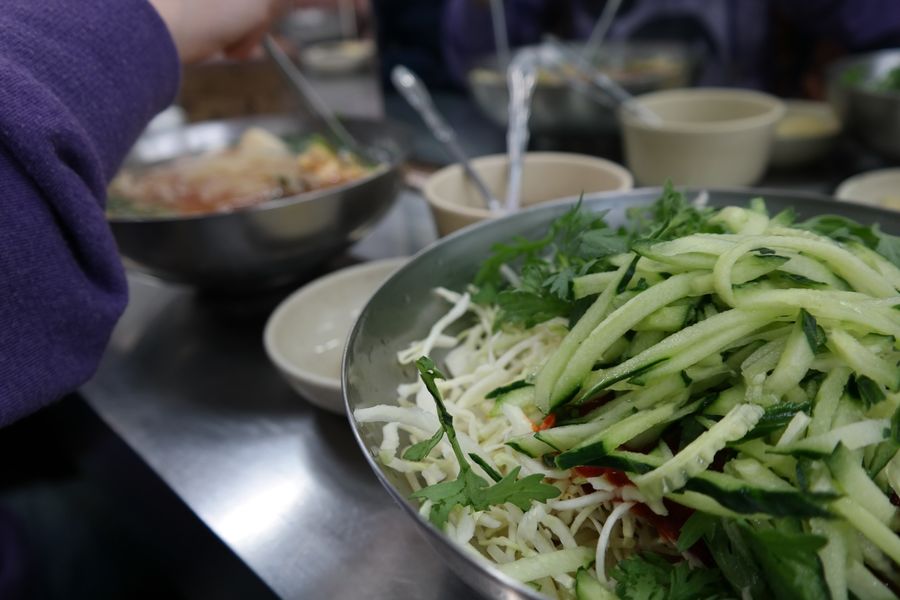
We waited about 20 minutes while thinking hard which menu we will eat. And we finally decided to have odeng Jjolmyeon and bibim Jjolmyeon.

Odeng Jjolmyeon is a food that Jjolmyeon is put in udon buckwheat and made like a noodle with fish paste. It felt weird to have soup with it, but I got used to the chewy taste of the noodle stripes and stuffed them in my stomach.

It will be good to eat on a cold winter night. The taste was colorful to eat a mouthful of sliced green onions and crown daisies, fish paste and Jjolmyeon together.

And the second Jjolmyeon. It looks similar with other ordinary Jjolmyeons. Instead, there are lots of cucumber and cabbage and crown daisies in it. There are more vegetables than noodle~.
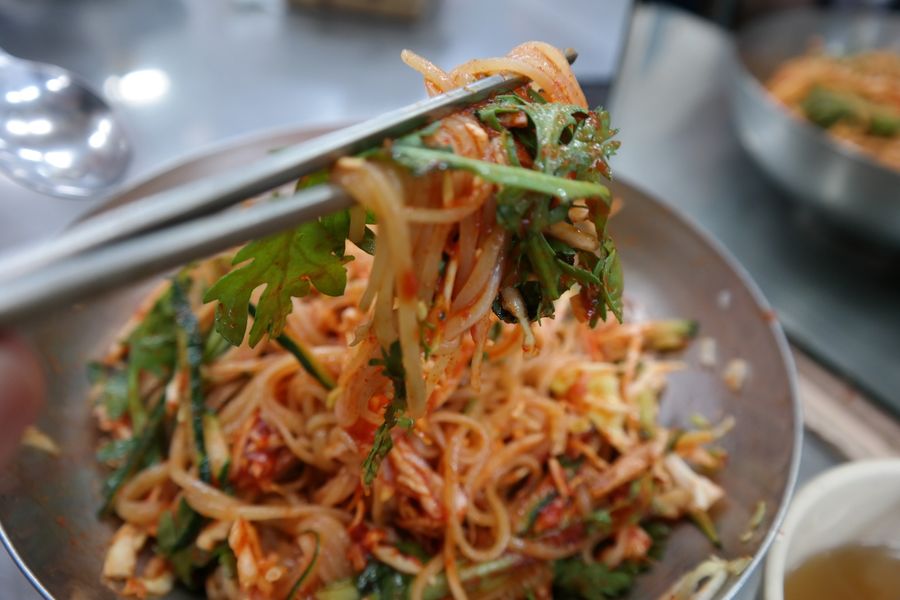
I mixed the seasoning and put one scoop in my mouth, tasting the fragrance of crown daisies. The adequate spicy taste and the sweet seasoning taste is the same with other Jjolmyeons.
I concentrated on eating with a Pickled Radish, and finished the Jjolmyeon by drinking up the last soup of odeng Jjolmyeon. Waited 20 minutes, and finished eating in 10 minutes.
Next time when I visit here, I think I'll have to think hard whether I will eat odeng or bibim, like when we dilemma at a Chinese restaurant, trying to decide between Jajangmyeon and Jjambbong.
And the hostess who smiled and said goodbye to all those people made me think the service is also good, along with the food.
Both menus were good to try as delicacy, but still, I think Korean should have rice for a meal. I recommend visiting here to have a snack.
Address : Gyeongju, Gyeongsangbuk-do nodongdong 80-8 (경상북도 경주시 노동동 80-8)
Phone Number : 054-743-5310
Opening hours : 08:00 to 21:00
Tomb of General Kim Yu-sin 김유신장군묘
The next site we will visit is the tomb of general Kim Yu-sin, the main character of the Union of Silla.
The tomb of general Kim Yu-sin is located at an area where it's tricky to use a public transportation. It's located in the middle of the mountain which is beyond Hyeongsan river, and even taxis don't come here well, it's one of the difficult places to visit, even though it's nearby.

The area of the tomb is divided into two parts. The left is the tomb of general Kim Yu-sin and the right is Sungmujeon area, where the ancestral tablet of general Kim Yu-sin is kept.
A unique thing of Sungmujeon is that the framed picture is written by president Kim Dae-jung. But because of the transportation problem we looked around the other area except of Sungmujeon.

When you go up the area, the very first thing that welcomes you is the monument with carved letters saying 'Memoriol of the Unification of Three Kingdoms'. There is a Memorial Stone that has the biography 'Silla Taedaegakkan' of general Kim Yu-sin written in Jeunsu writing.
Kim Yu-sin is born from a father Gimseoyeon who is a royalty of Geumgwan Gaya and the mother Princess Manmyung is the nephew of King Jinheung. Kim Yu-sin was the Poongwalju, leader of Hwarang, and married with the sister of king Muyeol Kim Chun-chu and became the main person to unite Silla.
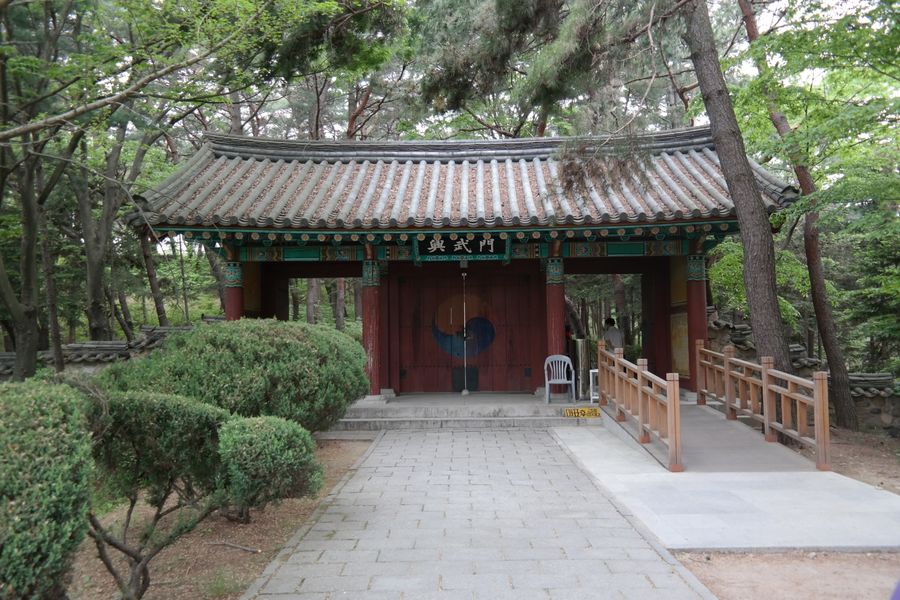
After looking over the monument we went through Heungmumun, the entrance of the tomb. A trail with dense tress filled with the chirping sound of birds comes out.

When you go on the trail for 100m, you can meet the tomb of Kim Yu-sin.

After a short walk an empty place comes out and the well managed tomb of Kim Yu-sin is on the high stairs. Actually this staircase is another photo zone for students who came for field trip. I remember too.

When you stand above around the burial mound of Kim Yu-sin, there are tombstone on each side. The left tombstone is written 'Silla taedaegakkan Kim Yu-sin tomb'.
Gakkan means the highest government post of the 17 official ranks of Silla. Daegakkan was made by discretion after Baekje was collapsed, and after Goguryeo was collapsed by Silla, more higher Taedaegakkan was named.

The right tombstone is one made during the time under the rule of Japanese imperialism and is written 'The Royal Tomb of King Gaegukgongsunchung jangnyeolheungmu'. There are two interesting facts about this tombstone.
Why is it called the tomb of King Heungmu the Great, not tomb of Kim Yu-sin? The answer to the first question is that after Kim Yu-sin's death, people deserved his accomplishments and called him 'King Heungmu the Great', almost as a king in during the era of king Heungdeok.
In photo, the writing is a bit weird. This letter only shows 'leung' when it's dry, but when it is wet, the letter 'myo' is clearly seen.
Some people argue that it's because people who doesn't admit Kim Yu-sin as a king did this, but nobody knows the criminal. Only the fact that the right tombstone of Kim Yu-sin's tomb is always wet by the water tourists had sprayed.

Kim Yu-sin's tomb is unique that it is surrounded by rocks. 12 memorial stones shaped like 12 animal system is surrounding it.
They have features that they are all looking at the left side and they are wearing casual clothes, with weapons. The tomb is the most fancy one with the most fancy decorations than any other royal tombs, such as the Royal Tomb of King Jinpyeong, Royal Tomb of Queen Seon-duk, Royal Tomb of King Muyeol.
Maybe because he raised many accomplishments as a general, compared to any other kings.
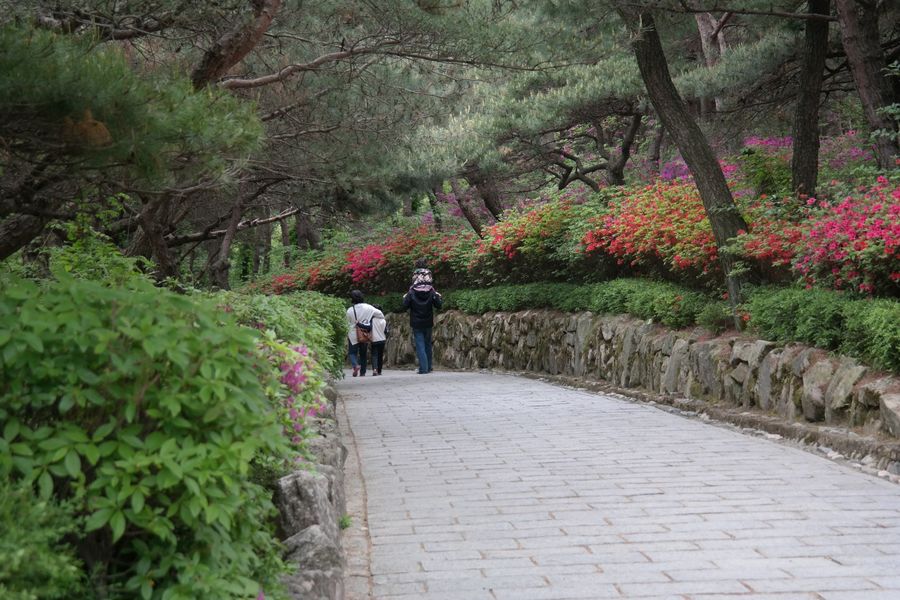
When we had came to the trail that had led us to the tomb,
In front of us was a happy family with children holding their mother's waist and riding on their father's shoulders, while going down the trail along the flower road.
Ahh... By the way, Gyeongju citizens appraise that the cherry flowers around Kim Yu-sin's tomb are much better than Bomun Tourist Complex, so take that in mind when you visit..
Address: Gyeongju, Gyeongsangbuk-do chunghyodong acid 7-10 (경상북도 경주시 충효동 산7-10)
Phone Number: 054-749-6713
Opening hours: 9:00 to 22:00










